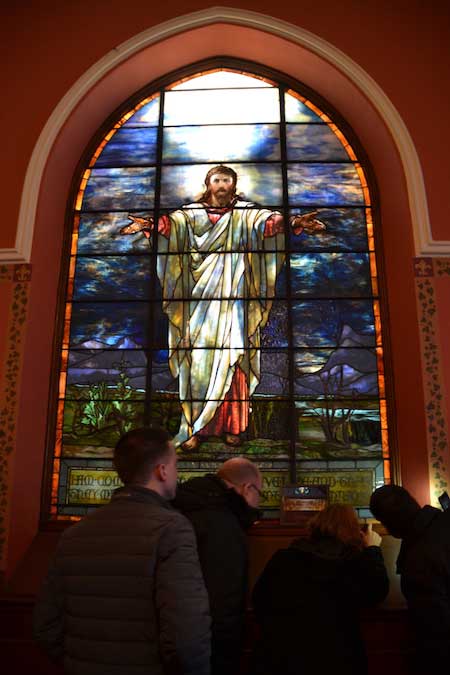Leadership Orleans learns about arts and cultural locally
Photos by Tom Rivers
ALBION – Leadership Orleans, which is in its first year in Orleans County, held its arts and culture program on Thursday. The day started at the St. Joseph’s Lyceum where the Rosario family, owner of Mariachi De Oro Mexican Grill, made Mexican food for breakfast and then taught the class some Mexican folk dances.
R.J. Linder, a loan officer or credit representative with Farm Credit East, dances with Galilea Rosario.
Leonel Rosario, one of the owners of Mariachi, shared how the family opened the restaurant in Medina 6 ½ years ago, serving authentic Mexican food. Mariachi last year was honored as the “Business of the Year” by the Orleans County Chamber of Commerce.
Leonel, his wife Dolores and their children Leonel and Galilea introduced the 25 members of the class to Mexican dance and food. Leonel’s mother Lucha also helped with the breakfast.
Bill Lattin, the retired Orleans County historian, also shared early county history. Albion and other canal villages were jumpstarted with the opening of the Erie Canal in 1825. That is also the year Orleans split from Genesee and was recognized as its own county.
Lattin said the Medina sandstone quarries were a dominant industry. The stone was readily available to build the impressive churches, government buildings and residences in Albion and the canal towns.
Medina sandstone, however, was most commonly used for streets, sidewalks and curbs. While its known as Medina sandstone, the rock was more plentiful in quarries east of Medina in Eagle Harbor, Albion, Hulberton and Holley, Lattin said.
Lattin, shown speaking inside the Lyceum, gave the group tours of Pullman Memorial Universalist Church and the First Presbyterian Church. Those sites, as well as the Lyceum, were built of Medina sandstone. Lattin said the residents and community leaders in the 1800s were full of optimism and confidence as the community took shape.
“They wanted to make a statement,” he said, talking about the soaring structures in the Courthouse Square. “This was a community of wealth in the 19th Century. They wanted to show it off.”
The churches, downtown business district, Courthouse and ornate residences were built in a variety of different architectural styles. Lattin said that diversity “is really one of the cultural assets that we have.”
At the Pullman Church, Lattin shared how George Pullman, an Albion native who made a fortune with well-furnished sleeping cars for the railroad industry, offered to match $5,000 to build the Universalist Church. The scale of the project grew and Pullman would pay $67,000 to build the new church, which included a Johnson pipe organ and 41 stained glass windows from the Tiffany Glass & Decorating Company.
Pullman worked in the furniture and cabinet business in Albion before heading to Chicago, where he became a leading industrialist with his success with the sleeping cars. (He also worked at moving buildings in Chicago.) The Pullman church is a memorial to his parents, James and Emily. Two of the sofas made by Pullman are still used at the Merrill-Grinnell Funeral Home in Albion.
The Christ the Consoler window in the church was slightly delayed which pushed back the dedication of the church to Jan. 31, 1895. The window is signed by the Tiffany company. Its leader, Louis Tiffany, traveled to Albion to oversee the window’s installation. The church wanted a window with the outstretched arms of Christ to fit the denomination’s welcoming tradition.
Lattin said the window cost $5,000 in 1895.
“This window is one of the great we have here in Orleans County,” Lattin said.
The arts and cultural day for Leadership Orleans included lunch at the Shirt Factory Café, a tour of the Hart House Hotel by owner Andrew Meier, a stop at 8:10 Meadworks and other Medina businesses, a group activity at Brushstrokes Studios and a diversity training program led by Betty Garcia Mathewson at The Colonade.
The year-long Leadership Orleans includes 25 people. Each month they focus on a different aspect of the county. Last month they learned about local government, meeting with officials at the village, town, county and state level.






































































